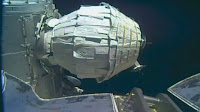NASA successfully inflated its first expandable space habitat Saturday and now it’s almost ready for astronauts to step inside.
Scientists fully inflated the experimental habitat, which is attached to the International Space Station. The pressurization process began at 4:34 p.m. ET and 10 minutes later, all eight tanks reached full pressurization, according to NASA.
Thursday, something had gone wrong. Scientists noticed a problem with BEAM when the pressure to volume ratio wasn’t adding up.The impact of the compression affected the layers
After analyzing data from the first attempt, the space agency and Bigelow Aerospace believed they identified the problem.The answer was fabric friction, Bigelow engineer Lisa Kauke said.
When BEAM was added to the SpaceX Falcon 9 rocket payload, it may have been packed up longer than expected, according to Bigelow engineers.The fabric-like material that BEAM is made from was compressed, changing the way the material behaved in space temporarily, making it more rigid during the expansion process during that first test.Layers have a memory to them. The longer they are packed the longer it takes for the materials to relax.
So NASA and Bigelow Aerospace had decided to stop inflating the habitat on Thursday, just to make sure there was no damage to the space station during the process.
Their latest retest on Saturday fully expanded and pressurized BEAM.
Right now, NASA plans to have astronauts enter BEAM three to four times a year to see how the habitat is faring. They’ll have to see how the structure fares against solar radiation and extreme fluctuations in temperature.


